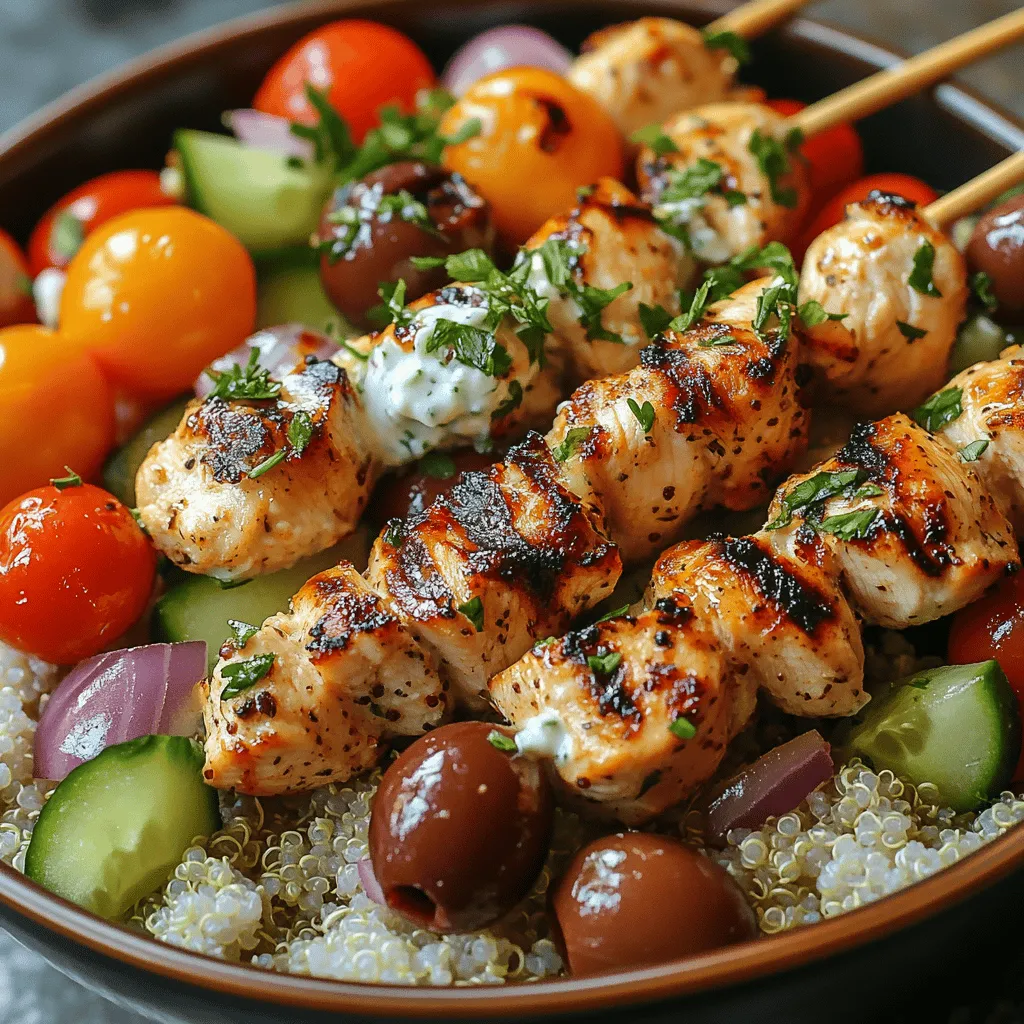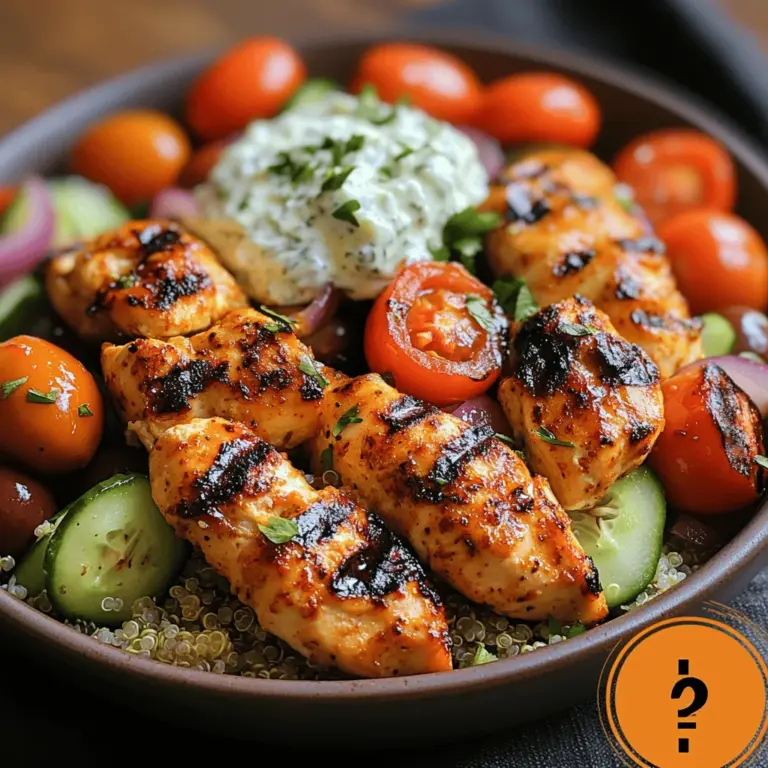Introduction
Greek cuisine is renowned for its vibrant flavors, fresh ingredients, and rich history, making it a favorite among food enthusiasts around the world. With an emphasis on wholesome ingredients, Greek dishes often highlight the Mediterranean diet, which is celebrated for its health benefits. Among the many culinary treasures that Greece has to offer, Chicken Souvlaki stands out as a beloved dish that embodies the essence of Greek cooking.
Souvlaki, which translates to “skewered meat,” has its roots deeply embedded in Greek culture. Traditionally made with marinated cubes of meat, it can also feature a variety of vegetables. The dish is often grilled to perfection, providing a smoky flavor that enhances the taste of the high-quality ingredients used. Chicken Souvlaki, in particular, has gained immense popularity due to its delectable taste and the ease with which it can be incorporated into a variety of meals.
The appeal of Greek Chicken Souvlaki Bowls lies in their versatility and health benefits. These bowls allow you to enjoy the succulent, flavorful chicken alongside nutritious components such as quinoa, a rainbow of roasted vegetables, and a refreshing tzatziki sauce. Whether you’re meal prepping for the week, serving a family dinner, or hosting a gathering with friends, these bowls are sure to satisfy. They are not only a feast for the eyes but also a nourishing option that makes it easy to incorporate fresh veggies and lean proteins into your diet.
Understanding the Ingredients
To create an unforgettable Greek Chicken Souvlaki Bowl, it’s essential to understand the key ingredients that contribute to its flavor and nutritional value. The primary components of this dish include chicken, quinoa, an assortment of colorful vegetables, and a creamy tzatziki sauce. Each ingredient plays a vital role in delivering the authentic taste of Greece while ensuring a balanced meal.
Chicken: The star of the dish, chicken breast is typically used for its lean quality and ability to absorb flavors. Marinating the chicken in a mixture of herbs, spices, and olive oil not only enhances its taste but also helps keep it moist during cooking.
Quinoa: This ancient grain is often used as a base for the bowl. Rich in protein and fiber, quinoa provides a nutty flavor and a satisfying texture. It’s gluten-free and packed with nutrients, making it an excellent alternative to rice or couscous.
Vegetables: A medley of seasonal vegetables such as bell peppers, red onions, and zucchini adds color and crunch to the bowl. These vegetables are not only delicious but also provide essential vitamins and minerals. Grilling or roasting them enhances their natural sweetness and complements the grilled chicken beautifully.
Tzatziki Sauce: This classic Greek condiment is made from creamy Greek yogurt, fresh cucumber, garlic, and herbs. Tzatziki adds a refreshing element to the dish, balancing the savory flavors of the chicken and vegetables. It’s also a good source of probiotics and can be easily customized to suit your taste preferences.
The importance of fresh herbs and spices in Greek cooking cannot be overstated. Ingredients like oregano, parsley, and garlic not only impart robust flavors but also offer various health benefits. Oregano, for instance, is known for its antioxidant properties, while parsley is packed with vitamins A, C, and K. Using fresh herbs in the marinade and tzatziki elevates the dish and brings about a taste of authenticity that is often missing in store-bought alternatives.
Marinating the Chicken
Marinating the chicken is a crucial step in preparing Greek Chicken Souvlaki Bowls. A well-crafted marinade not only infuses the meat with flavor but also ensures tenderness during the cooking process. The marinade typically contains olive oil, lemon juice, garlic, and a blend of spices, creating a harmonious combination that enhances the natural taste of the chicken.
Marinade Ingredients
To create the perfect marinade for your chicken, you will need the following ingredients:
– Olive Oil: A staple in Greek cuisine, olive oil adds richness and helps the marinade cling to the chicken.
– Lemon Juice: Freshly squeezed lemon juice adds acidity, which helps tenderize the chicken while imparting a bright flavor.
– Garlic: Minced garlic is essential for flavor, providing a bold and aromatic component to the marinade.
– Oregano: Dried oregano is a classic herb used in Greek cooking. It adds a warm, earthy flavor that pairs beautifully with chicken.
– Salt and Pepper: Essential for seasoning, salt enhances the overall flavor while pepper adds a touch of heat.
Importance of Marinating
The process of marinating chicken serves multiple purposes. Firstly, it enhances the flavor of the meat, allowing the spices and herbs to penetrate deeply. Secondly, the acid in the marinade (from the lemon juice) helps break down the protein fibers in the chicken, resulting in a more tender and juicy final product. Additionally, marinating for an adequate amount of time allows the flavors to meld and develop, creating a more complex taste.
Step-by-Step Guide to Marinate the Chicken
1. Prepare the Marinade: In a mixing bowl, combine 1/4 cup of olive oil, the juice of one lemon, 3-4 minced garlic cloves, 1 tablespoon of dried oregano, and salt and pepper to taste. Whisk the ingredients together until well blended.
2. Cut the Chicken: Use boneless, skinless chicken breasts for this recipe. Cut the chicken into 1-inch cubes to ensure even marination and cooking.
3. Combine Chicken and Marinade: Place the chicken cubes in a large zip-top bag or a shallow dish. Pour the marinade over the chicken, making sure each piece is well coated.
4. Seal and Refrigerate: If using a zip-top bag, seal it tightly, removing as much air as possible. If using a dish, cover it with plastic wrap or a lid. Refrigerate the marinating chicken for at least 30 minutes, although for optimal flavor, aim for 2-4 hours. For the best results, marinating overnight is recommended.
5. Prepare for Cooking: Once the marinating time has elapsed, remove the chicken from the refrigerator and let it sit at room temperature for about 15-20 minutes before cooking. This step helps the chicken cook evenly.
Suggested Marination Times
– Quick Marination (30 minutes): If you’re short on time, a quick 30-minute marination will still impart some flavor.
– Optimal Flavor (2-4 hours): Allowing the chicken to marinate for a few hours will yield a noticeable improvement in taste and tenderness.
– Overnight: For the best results, marinating the chicken overnight allows the flavors to develop fully and results in the juiciest chicken.
In summary, marinating the chicken is a vital step that should not be overlooked. The right marinade not only enhances the flavor but also transforms the texture of the chicken, ensuring a delicious Greek Chicken Souvlaki Bowl that you and your loved ones will crave time and time again.
Next, we’ll dive into the art of creating the perfect tzatziki sauce, a refreshing complement that brings the entire dish together.

Recommended Cooking Methods: Grilling vs. Pan-Searing
When it comes to cooking Greek Chicken Souvlaki, the method you choose can significantly impact the flavor and texture of the dish. The two most recommended cooking methods are grilling and pan-searing.
Grilling: This method is favored for its ability to infuse the chicken with a smoky flavor, which is characteristic of traditional Greek souvlaki. Grilling over high heat creates those beautiful charred marks and allows excess fat to drip away, which is beneficial for both flavor and health. If you’re grilling outdoors, use a charcoal grill for an authentic taste, or opt for a gas grill for convenience.
Pan-Searing: If grilling isn’t an option, pan-searing is a fantastic alternative. A heavy skillet or grill pan can achieve a great sear on the chicken, providing a nice crust while keeping the interior juicy. Heat the pan over medium-high heat and add a little olive oil to prevent sticking. While it may not replicate the smoky flavor from grilling, it still produces delicious results.
Prepping Skewers: The Importance of Soaking Wooden Skewers
Before you start threading the marinated chicken onto skewers, it’s essential to prepare your skewers properly, especially if you’re using wooden ones. Soaking wooden skewers in water for at least 30 minutes before grilling helps prevent them from burning. This simple step ensures that your skewers hold their shape and don’t catch fire on the grill, resulting in a better presentation and cooking experience.
If you opt for metal skewers, there’s no need for soaking, but make sure to grease them lightly to prevent sticking.
Detailed Instructions on Grilling Chicken Skewers
Now that you have your skewers prepped and your chicken marinated, it’s time to grill your souvlaki. Here’s a step-by-step guide to ensure perfectly cooked chicken skewers.
1. Preheat the Grill: Get your grill hot by preheating it to medium-high heat (about 400-450°F or 200-230°C). This temperature is ideal for achieving nice grill marks and a crispy exterior.
2. Thread the Chicken: Take your marinated chicken pieces and thread them onto the soaked skewers, leaving a little space between each piece to allow for even cooking.
3. Grill the Skewers: Place the skewers on the grill and cook for about 10-12 minutes, turning them every few minutes to ensure even cooking. The chicken should reach an internal temperature of 165°F (75°C) for safe consumption.
4. Achieving a Charred Finish: For a beautifully charred finish, you can move the skewers closer to the flame for the last couple of minutes of cooking. Keep an eye on them to avoid burning, and look for an internal temperature check to ensure they’re fully cooked.
5. Rest the Chicken: Once cooked, remove the skewers from the grill and let them rest for 5 minutes. This resting period allows the juices to redistribute, ensuring tender and juicy chicken.
Assembling the Greek Chicken Souvlaki Bowls
Presentation plays a crucial role in making meals appealing. A well-assembled bowl not only looks good but also enhances the dining experience. Here’s how to create beautiful Greek Chicken Souvlaki Bowls that are sure to impress.
1. Start with a Base: Begin with a base of fluffy rice, couscous, or a bed of crisp greens like romaine or spinach. This foundation will soak up the flavors and add texture to your bowl.
2. Add the Grilled Chicken: Place the grilled chicken skewers on top of your base, making sure to remove the chicken from the skewers for easy eating.
3. Incorporate Toppings: Add a variety of toppings such as diced tomatoes, cucumber, red onion, kalamata olives, and crumbled feta cheese. Each ingredient adds a burst of flavor and color.
4. Drizzle with Tzatziki: No Greek dish is complete without tzatziki. Drizzle this creamy yogurt sauce over the top for added moisture and flavor.
5. Finish with Fresh Herbs: Sprinkle fresh parsley or dill over the top for a pop of color and flavor. The vibrant greens will enhance the overall presentation.
Suggestions for Customizing Bowls
One of the fantastic aspects of Greek Chicken Souvlaki Bowls is their versatility. You can customize your bowl with various toppings and ingredients according to your preferences. Here are some ideas:
– Grains: Swap rice for quinoa or farro for a different texture and taste.
– Vegetables: Add roasted or grilled vegetables like bell peppers, zucchini, or eggplant for extra flavor and nutrients.
– Sauces: Experiment with different sauces by swapping tzatziki for hummus or a lemon-herb vinaigrette for a lighter option.
– Proteins: For a vegetarian version, replace chicken with marinated tofu or chickpeas, providing a plant-based protein source.
The Role of Color and Texture in Creating Visually Appealing Dishes
Color and texture are essential components of any dish, as they engage the senses and make meals more appetizing. In your Greek Chicken Souvlaki Bowls, aim for a balance of colors—vibrant greens from herbs and vegetables, deep reds from tomatoes, and creamy whites from tzatziki and feta.
Incorporating a variety of textures, from the crunch of fresh vegetables to the tenderness of grilled chicken, makes each bite interesting. Thoughtful presentation will not only enhance your meal visually but also delight those you share it with.
Serving Suggestions
To make your Greek Chicken Souvlaki Bowls even more delightful, consider these serving suggestions:
Side Dishes: Pair your souvlaki bowls with a side of Greek salad, roasted potatoes, or pita bread. These sides complement the flavors of the bowl while adding variety to the meal.
Beverage Pairings: Enhance your dining experience with beverages that echo Mediterranean flavors. Traditional Greek drinks like ouzo or retsina can elevate your meal, but modern options such as lemon-infused iced tea or a crisp white wine also work beautifully.
Meal Prepping: If you’re looking for lunch options, these bowls are perfect for meal prepping. Prepare the chicken and toppings in advance, allowing you to quickly assemble a delicious and nutritious meal throughout the week.
Health Benefits of Greek Chicken Souvlaki Bowls
Greek Chicken Souvlaki Bowls are not only delicious but also packed with health benefits. Here’s a nutritional analysis of the dish:
– Protein: Chicken is an excellent source of lean protein, which is essential for muscle repair and growth. Each serving provides a substantial amount of protein, helping to keep you full and satisfied.
– Healthy Fats: The use of olive oil in marinades and dressings provides healthy monounsaturated fats, which are beneficial for heart health.
– Fiber: Incorporating whole grains, fresh vegetables, and legumes into your bowl adds fiber, supporting digestive health and promoting a feeling of fullness.
In addition, the Mediterranean diet, rich in fruits, vegetables, whole grains, and healthy fats, has been linked to numerous health benefits, including reduced inflammation, improved heart health, and better weight management.
This recipe can fit into various dietary lifestyles, including low-carb and gluten-free options. Swap grains for leafy greens to create a low-carb bowl, or use gluten-free grains like quinoa to ensure it’s suitable for a gluten-free diet.
Conclusion
Greek Chicken Souvlaki Bowls are a delightful combination of flavors, textures, and colors that make for a satisfying meal. With their health benefits, versatility, and ease of preparation, they are perfect for family dinners, meal prepping, or impressing guests at a gathering.
By trying this recipe, you can bring a taste of Greece into your home and enjoy the joy of sharing homemade meals with family and friends. The layered flavors of marinated chicken, fresh vegetables, and creamy tzatziki create an unforgettable dish that celebrates the essence of Mediterranean cuisine. So gather your ingredients, fire up the grill, and embark on a culinary journey that transports you to the sun-soaked shores of Greece.


